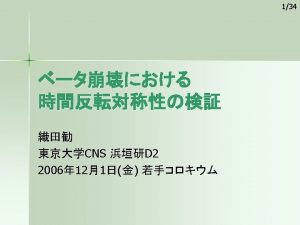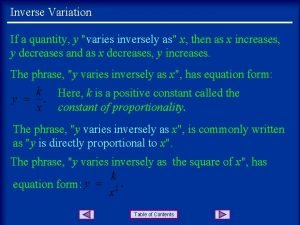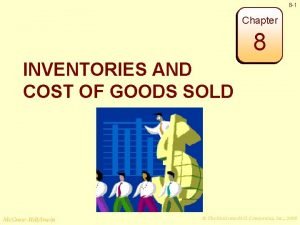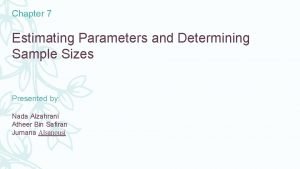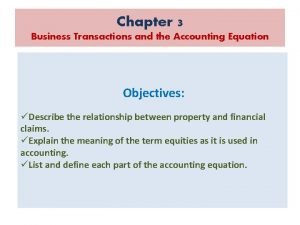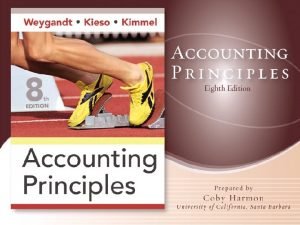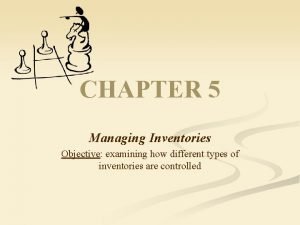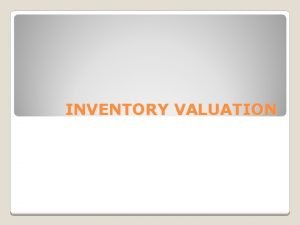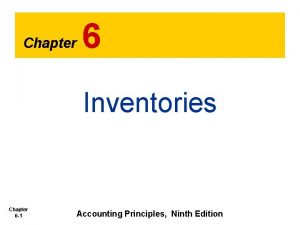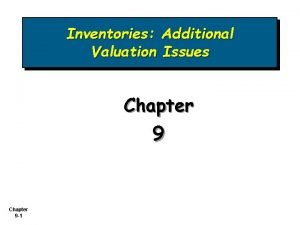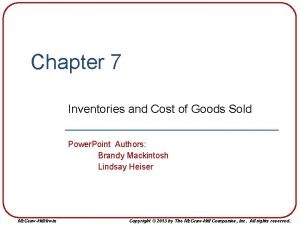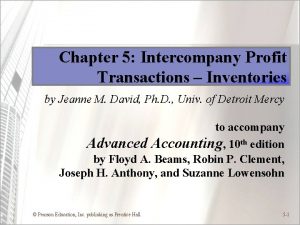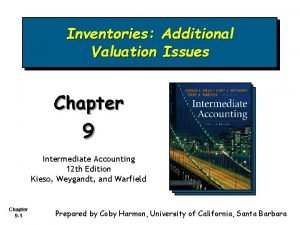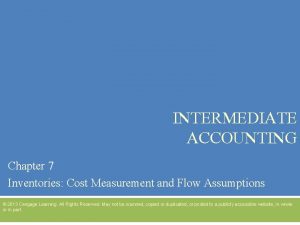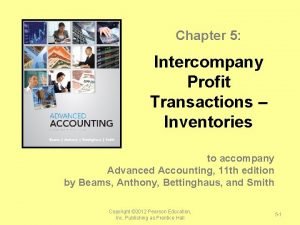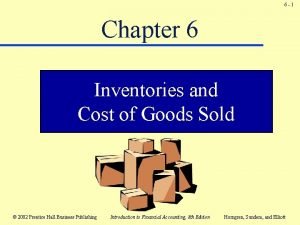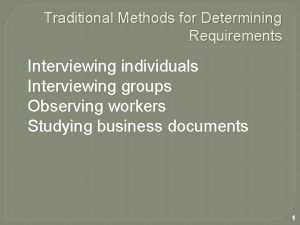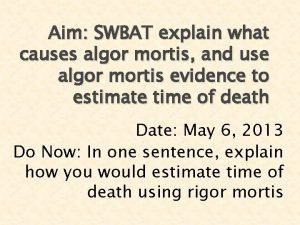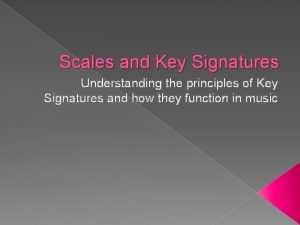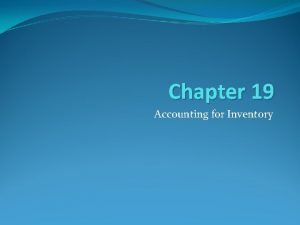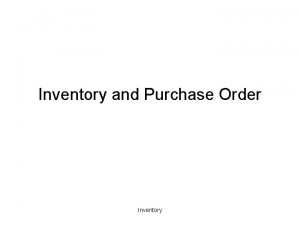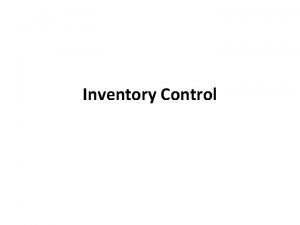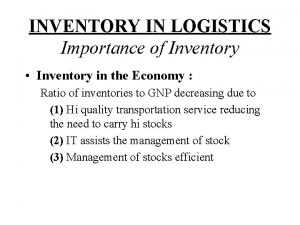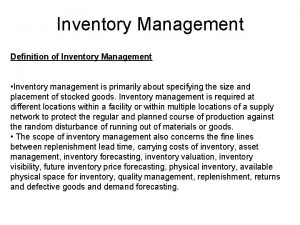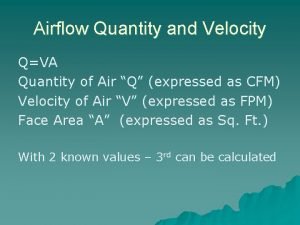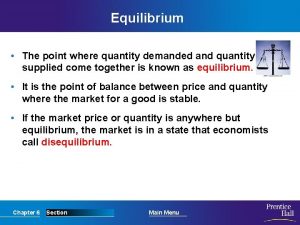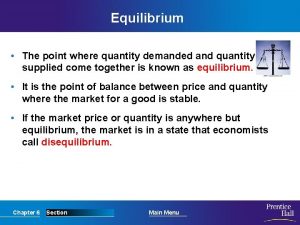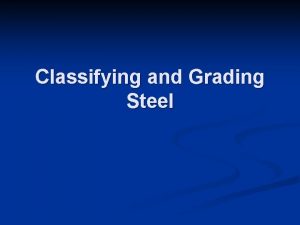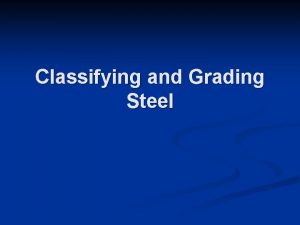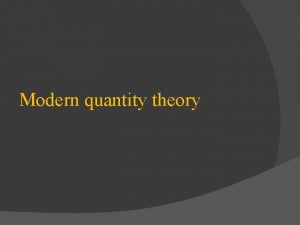Chapter6 Inventories Classifying Inventories Determining Inventory Quantity and


































- Slides: 34

Chapter-6: Inventories Classifying Inventories Determining Inventory Quantity and Ownership Inventory Costing Inventory Errors Statement Presentation and Analysis 1

Classifying Inventories Merchandising Company • One Classification: • Merchandise Inventory Manufacturing Company • Three Classification: • Raw Materials • Work-in-process • Finished Goods Regardless of the classification, companies report all inventories under Current Assets on the balance sheet. 2

Determining Inventory Quantities and Ownership Taking a Physical Inventory Involves counting, weighing, or measuring each kind of inventory on hand. Taken, u when the business is closed or business is slow. u at end of the accounting period. 3

Determining Inventory Quantities and Ownership Reasons for taking Physical Inventory Perpetual System 1. Check accuracy of inventory records. 2. Determine amount of inventory lost (wasted raw material shoplifting, or employee theft). Periodic System 1. Determine the inventory on hand. 2. Determine the cost of goods sold for the period. 4

Determining Inventory Quantities and Ownership Determining Ownership of Goods in Transit u Purchased goods not yet received. u Sold goods not yet delivered. Goods in transit should be included in the inventory of the company that has legal title to the goods. Legal title is determined by the terms of sale. 5

Determining Inventory Quantities and Ownership Determining Ownership of Goods: Goods in Transit Ownership of the goods passes to the buyer when the public carrier accepts the goods from the seller. Ownership of the goods remains with the seller until the goods reach the buyer. 6

Determining Inventory Quantities and Ownership Determining Ownership of Goods Consigned Goods u Goods held for sale by one party. u Ownership of the goods is retained by another party. 7

Inventory Costing Scenario: Assume that Crivitz TV Company purchases three identical 50 -inch TVs on different dates at costs of $700, $750, and $800. During the year Crivitz sold two sets at $1, 200 each. These facts are summarized below. 8

Inventory Costing Unit costs can be applied to quantities on hand using the following costing methods: u Specific Identification u First-in, first-out (FIFO) u Last-in, first-out (LIFO) u Average-cost 9

Inventory Costing Specific Identification Actual physical flow costing method in which items still in inventory are specifically costed to arrive at the total cost of the ending inventory. u Practiced in Perpetual system u In Periodic system it’s practice is relatively rare. u Most Periodic system based companies make assumptions (Cost Flow Assumptions) about which units were sold. 10

Inventory Costing Specific Identification If Crivitz sold the TVs it purchased on February 3 and May 22, then its cost of goods sold is $1, 500 ($700 + $800), and its ending inventory is $750. 11

Inventory Costing Cost Flow Assumption Do not need to match the physical movement of goods. Types of Cost Flow Assumptions are: First-in, first-out (FIFO) Last-in, first-out (LIFO) Average Cost Methods should be used consistently, enhances comparability. Although consistency is preferred, a company may change its inventory costing method. 12

Inventory Costing Scenario: Data for Houston Electronics’ Astro condensers. *(Beginning Inventory + Purchases) - Ending Inventory = Cost of Goods Sold Or, *Cost of goods available for sale - Ending Inventory = Cost of Goods Sold 13

Inventory Costing First-In-First-Out (FIFO) u Earliest goods purchased are first to be sold. u Often parallels actual physical flow of merchandise. u Generally good business practice to sell oldest units first. 14

Inventory Costing First-In-First-Out (FIFO) 15

Inventory Costing First-In-First-Out (FIFO) 16

Inventory Costing Last-In-First-Out (LIFO) u Latest goods purchased are first to be sold. u Seldom coincides with actual physical flow of merchandise. u Includes goods stored in piles, such as coal or hay. 17

Inventory Costing Last-In-First-Out (LIFO) 18

Inventory Costing Last-In-First-Out (LIFO) 19

Inventory Costing Average Cost u Allocates cost of goods available for sale on the basis of weighted-average unit cost incurred. u Assumes goods are similar in nature. u Applies weighted-average unit cost to the units on hand to determine cost of the ending inventory. 20

Inventory Costing Average Cost 21

Inventory Costing Average Cost 22

Inventory Costing Financial Statement and Tax Effects 23

Inventory Costing Lower-of-Cost-or-Market When the value of inventory is lower than its cost u Companies can “write down” the inventory to its market value in the period in which the price decline occurs. u Market value = Replacement Cost u Example of conservatism. 24

Inventory Costing Lower-of-Cost-or-Market Example: Assume that Ken Tuckie TV has the following lines of merchandise with costs and market values as indicated. 25

Inventory Errors Common Cause: u Failure to count or price inventory correctly. u Not properly recognizing the transfer of legal title to goods in transit. u Errors affect both the income statement and balance sheet. 26

Inventory Errors Income Statement Effects Inventory errors affect the computation of cost of goods sold and net income. 27

Inventory Errors Income Statement Effects Inventory errors affect the computation of cost of goods sold and net income in two periods. u An error in ending inventory of the current period will have a reverse effect on net income of the next accounting period. u Over the two years, the total net income is correct because the errors offset each other. u Ending inventory depends entirely on the accuracy of taking and costing the inventory. 28

Inventory Errors Combined income for 2 -year period is correct. ($3, 000) Net Income understated $3, 000 Net Income overstated 29

Inventory Errors Balance Sheet Effects Effect of inventory errors on the balance sheet is determined by using the basic accounting equation: . 30

Statement Presentation and Analysis Presentation Balance Sheet - Inventory classified as current asset. Income Statement - Cost of goods sold subtracted from sales. There also should be disclosure of 1) major inventory classifications, 2) basis of accounting (cost or LCM), and 3) costing method (FIFO, LIFO, or average). 31

Statement Presentation and Analysis Inventory management is a dilemma 1. High Inventory Levels - may incur high carrying costs (e. g. , investment, storage, insurance, obsolescence, and damage). 2. Low Inventory Levels – may lead to stockouts and lost sales. 32

Statement Presentation and Analysis Inventory turnover measures the number of times on average the inventory is sold during the period. Inventory Turnover Cost of Goods Sold = Average Inventory Days in inventory measures the average number of days inventory is held. Days in Inventory Days in Year (365) = Inventory Turnover 33

Statement Presentation and Analysis Example: Wal-Mart reported in its 2010 annual report a beginning inventory of $34, 511 million, an ending inventory of $33, 160 million, and cost of goods sold for the year ended January 31, 2010, of $304, 657 million The inventory turnover formula and computation for Wal-Mart are shown below. Days in Inventory: Inventory turnover of 9 times divided into 365 is approximately 40. 6 days. This is the approximate time that it takes a company to sell the inventory. 34
 Example of scalar
Example of scalar What is vector quantity
What is vector quantity Navigator method physics
Navigator method physics Scalar quantity and vector quantity
Scalar quantity and vector quantity Inversely equation
Inversely equation Chapter 8 inventories and the cost of goods sold
Chapter 8 inventories and the cost of goods sold Earthquake p wave and swave travel time
Earthquake p wave and swave travel time What is the point estimate of μ?
What is the point estimate of μ? Problem 3-11 completing the accounting equation answer key
Problem 3-11 completing the accounting equation answer key Example of policy claim
Example of policy claim Informal assessments for reading
Informal assessments for reading Inventory in the balance sheet
Inventory in the balance sheet Recycled inventories in housekeeping
Recycled inventories in housekeeping Wac inventory
Wac inventory Juloidian inventories
Juloidian inventories Functions of inventories
Functions of inventories Chapter 6 inventories
Chapter 6 inventories Chapter 9 inventories additional valuation issues
Chapter 9 inventories additional valuation issues Cost of good sold formula
Cost of good sold formula Intercompany inventory transactions
Intercompany inventory transactions Lower of cost or market
Lower of cost or market Chapter 7 inventories answers
Chapter 7 inventories answers Intercompany inventory transactions
Intercompany inventory transactions Smarter inventories
Smarter inventories Chapter 6 inventories
Chapter 6 inventories How can ngt be used for requirements determination?
How can ngt be used for requirements determination? Osmometry molecular weight determination
Osmometry molecular weight determination How to determine the rate determining step
How to determine the rate determining step Margin of safety formula
Margin of safety formula Oxidation state rules
Oxidation state rules Time of death estimations worksheet
Time of death estimations worksheet Importance of the level of product availability
Importance of the level of product availability When to use sdlc
When to use sdlc Do not use key signature
Do not use key signature What is transport number in chemistry
What is transport number in chemistry



